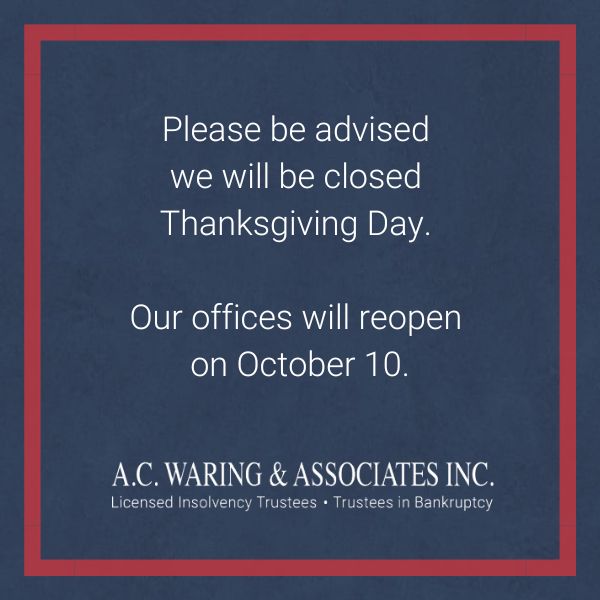Not being able to cover all of your debt payments is undoubtedly stressful. In these moments it’s important to understand that you have options to help you regain control of your finances. One of these options could be declaring bankruptcy.
Bankruptcy, conducted by a Licensed Insolvency Trustee, is the process of corralling your creditors and stopping any collection action. Once discharged from bankruptcy in 9 to 36 months, you’ll have an opportunity to start fresh financially without the stress of unpaid debt looming over your head.
While bankruptcy can help eliminate certain debts, there are still costs you must consider before making a decision. In fact, in some cases, bankruptcy may not always be the best option for every situation particularly when the individual has a relatively high income or significant equity in assets in excess of the provincial exemption laws. Depending on your income and non-exempt assets, your creditors may receive some dividend from the proceeds from your bankrupt estate. It is not common, however, for your creditors not to receive anything.
If you are struggling with the weight of unpaid debt on your shoulders, please don’t hesitate to speak to the team at A.C. Waring & Associates, Inc. You can also visit our Bankruptcy, Personal Bankruptcy, and Business Bankruptcy pages to learn more about the process.
Seize the possibility for a brighter financial future.
Types of Bankruptcy & How They’re Different
There are 2 types of bankruptcies: “summary” bankruptcy, and ”ordinary” bankruptcy. Corporations are always deemed “ordinary” bankruptcies. Summary bankruptcies are situations where the non-exempt assets, available to unsecured creditors., are less than $15,000. If your corporation files for bankruptcy, there are no provincial exemptions relative to its’ assets and they are all liquidated.
Legally speaking, corporate entities are considered separate entities from their shareholders. If corporate bankruptcy is your intention you’ll need to speak to a Licensed Insolvency Trustee with experience in corporate bankruptcy filings.
For the purposes of this blog, we’re going to look at the costs associated with a “summary” bankruptcy.
The Cost of Bankruptcy
When you file for bankruptcy, you’ll work with a Licensed Insolvency Trustee to determine which assets are subject to creditor claims to pay your creditors.
Assets sold by your Licensed Insolvency Trustee vary depending on your situation, but some can include:
- Vehicles – in Alberta, each person is allowed a vehicle to a value of $5,000 or equity in a financed vehicle to a value of $5,000. (However, there is rarely any equity in a financed vehicle)
- Home equity – is exempt in Alberta to a maximum of $40,000
- Collections of value (eg. stamps, coins) are not exempt
- Items that cannot be described as ‘furniture and appliances or clothing’ are not exempt
- Savings and investments – are not specifically exempt, however, RRSP’s and Registered Education savings plans are exempt.
Certain provincial laws may protect specific assets, so be sure to provide your Licensed Insolvency Trustee a complete list of your assets so as to determine what is exempt or not.
The Superintendent of Bankruptcy determines the income guidelines relative to exempt income formulated to ensure that you have enough money to support your and your family’s basic needs during bankruptcy.
Still, there are other costs you’ll need to consider before you can file for bankruptcy:
Your Base Contribution
Base contribution costs refer to certain fees you’ll need to pay to file for bankruptcy. The minimum Canadians can expect to pay is approximately $1,800 for their base contribution (spread over a 9 month period). If your income is significantly higher than the Superintendent of Bankruptcy’s income guidelines, you may have to contribute more each month.
Surplus Income
Every month, you’ll provide your Licensed Insolvency Trustee with a statement of income and expense together with supporting income verification to calculate if you made any surplus income. If you’ve made more money than the income guidelines you will have to pay one half of the excess into your bankruptcy estate. If you make more than $200 in surplus income, on average, over the first eight months of bankruptcy, your bankruptcy term will increase from 9 months to 21 months in a ‘first time’ bankruptcy situation.
Personal Costs.
- Although filing for Bankruptcy can severely affect your credit bureau report, the majority of people filing for bankruptcy already have an undesirable credit history with one or more of their creditors having the same negative effect in the bureau.
- If you’ve co-signed a loan with another person, like a spouse or a friend, they may be held responsible for paying back that loan after you declare bankruptcy.
- In addition to filing a monthly statement, you will need to attend two financial counselling sessions.
What If You File Bankruptcy a Second Time?
Second time bankruptcy filing is relatively the same process as the first. However, the effect that bankruptcy can have on your financial situation can last for much longer.
- The minimum period up to 24 months.
- If you average more than $200 in surplus income during this period, you will be in bankruptcy for a minimum of 36 months
- The effect a second bankruptcy has on your credit bureau report means it could last up to 14 years rather than 6 years on a first time bankruptcy.
If you file for bankruptcy a third time, you won’t be automatically discharged from your bankruptcy, and you’ll need to attend the discharge hearing in bankruptcy court. The court will then decide to grant the discharge, delay it, or refuse it.
What Else Can You Do?
Bankruptcy may not be the best choice for every situation, so make sure you speak to a Licensed Insolvency Trustee so that you can discuss all the options available. In some cases, debt solutions like consumer proposals or debt consolidation may provide the relief you need from overwhelming debt.
Call the A.C. Waring & Associates Inc. team and find out how you can take control of your debt today.





